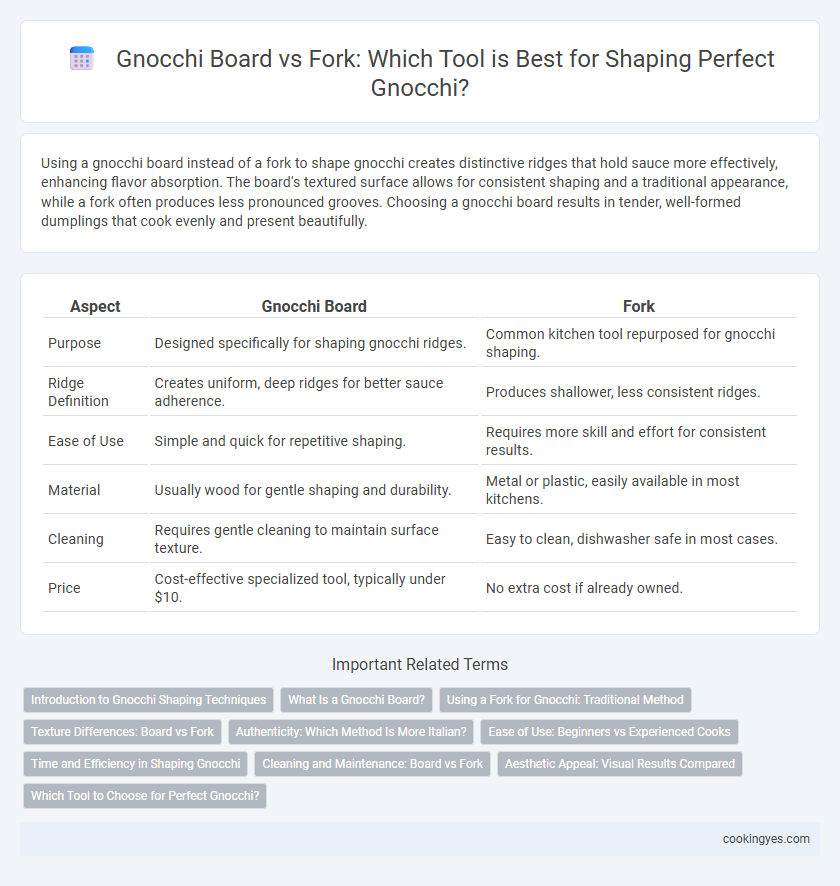Using a gnocchi board instead of a fork to shape gnocchi creates distinctive ridges that hold sauce more effectively, enhancing flavor absorption. The board's textured surface allows for consistent shaping and a traditional appearance, while a fork often produces less pronounced grooves. Choosing a gnocchi board results in tender, well-formed dumplings that cook evenly and present beautifully.
Table of Comparison
| Aspect | Gnocchi Board | Fork |
|---|---|---|
| Purpose | Designed specifically for shaping gnocchi ridges. | Common kitchen tool repurposed for gnocchi shaping. |
| Ridge Definition | Creates uniform, deep ridges for better sauce adherence. | Produces shallower, less consistent ridges. |
| Ease of Use | Simple and quick for repetitive shaping. | Requires more skill and effort for consistent results. |
| Material | Usually wood for gentle shaping and durability. | Metal or plastic, easily available in most kitchens. |
| Cleaning | Requires gentle cleaning to maintain surface texture. | Easy to clean, dishwasher safe in most cases. |
| Price | Cost-effective specialized tool, typically under $10. | No extra cost if already owned. |
Introduction to Gnocchi Shaping Techniques
Using a gnocchi board versus a fork for shaping gnocchi impacts texture and sauce retention. A gnocchi board creates deep grooves that hold sauces better, enhancing flavor absorption, while a fork produces finer ridges and is ideal for smaller batches. Mastering these shaping techniques improves the final dish's consistency and visual appeal.
What Is a Gnocchi Board?
A gnocchi board is a small wooden or plastic tool featuring ridges used to shape and texture gnocchi dough, creating characteristic grooves that help hold sauce. Unlike a fork, the gnocchi board ensures uniform ridges and a consistent shape, enhancing both presentation and sauce adherence. Using a gnocchi board streamlines the shaping process, producing traditional, restaurant-quality gnocchi with minimal effort.
Using a Fork for Gnocchi: Traditional Method
Using a fork for shaping gnocchi is a traditional method that creates the classic ridged texture, which helps sauce cling better to the pasta. This technique involves pressing each gnocchi piece gently against the fork tines, forming subtle grooves without flattening the dough. The fork method remains popular for its simplicity, portability, and ability to produce uniform, tender gnocchi with enhanced flavor absorption.
Texture Differences: Board vs Fork
Using a gnocchi board creates deeper, more defined ridges that allow sauces to cling better, enhancing flavor absorption and providing a firmer texture. In contrast, shaping gnocchi with a fork results in finer, shallower grooves, yielding a softer, more delicate bite. The choice between board and fork directly influences the gnocchi's surface texture and overall mouthfeel.
Authenticity: Which Method Is More Italian?
Authentic Italian gnocchi shaping traditionally relies on a fork to create light ridges that help sauce adhere, reflecting a regional technique passed down through generations. The gnocchi board, while popular in some Italian regions, especially in central Italy, is a modern innovation designed for uniformity and consistency. Overall, the fork method retains a stronger cultural authenticity linked to Italian culinary heritage.
Ease of Use: Beginners vs Experienced Cooks
Using a gnocchi board offers beginners a tactile guide to create consistent ridges quickly, enhancing both texture and sauce retention. Experienced cooks may prefer a fork for its speed and versatility, allowing them to shape gnocchi with slight variations for personalized texture. Both tools complement different skill levels, with the board emphasizing uniformity and the fork enabling creative flexibility in shaping gnocchi.
Time and Efficiency in Shaping Gnocchi
Using a gnocchi board significantly increases shaping efficiency by creating uniform ridges quickly, which helps sauces adhere better without requiring additional steps. A fork, while traditional, slows the process due to smaller, inconsistent indentations and requires more careful hand movements. Chefs aiming for faster output and consistent texture benefit from the gnocchi board's design, optimizing both time and final product quality.
Cleaning and Maintenance: Board vs Fork
Using a gnocchi board for shaping results in deeper grooves that can trap dough, requiring thorough cleaning to prevent residue buildup, though its smooth wooden surface is less prone to rust and easy to maintain with regular oiling. A fork, with its simpler design and fewer grooves, is quicker to clean but may not create as distinctive ridges, and metal forks can rust if not dried properly after washing. Both tools demand attention to moisture to preserve longevity, but the gnocchi board often requires more careful maintenance to avoid cracking or warping over time.
Aesthetic Appeal: Visual Results Compared
Using a gnocchi board creates uniform ridges that enhance sauce adherence and provide a classic, textured appearance prized by chefs and food enthusiasts. In contrast, shaping gnocchi with a fork produces subtler grooves and a more rustic look, appealing to those who prefer artisanal presentation. The choice directly impacts the visual appeal and texture, influencing both plating aesthetics and overall dining experience.
Which Tool to Choose for Perfect Gnocchi?
Choosing between a gnocchi board and a fork for shaping gnocchi depends on the desired texture and ease of use. A gnocchi board creates deeper ridges that better hold sauces, resulting in a traditional look and enhanced flavor absorption, while a fork provides finer grooves and is more accessible for beginners. For perfect gnocchi, use a gnocchi board if you prefer authentic ridges and sauce retention, or a fork for quicker shaping with a subtle texture.
Gnocchi board vs fork for shaping gnocchi Infographic

 cookingyes.com
cookingyes.com